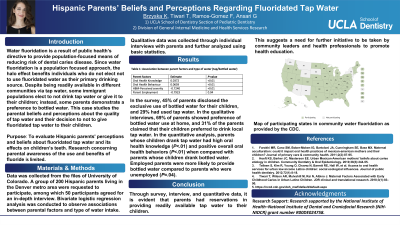Preventive
316 - Hispanic Parents’ Beliefs and Perceptions Regarding Fluoridated Tap Water

- KB
Karolina Brzyska, DDS (she/her/hers)
Pediatric Resident (PGY2)
Univeristy of California, Los Angeles
University of California, Los Angeles
Los Angeles, California, United States - TT
Tamanna Tiwari, BDS MDS MPH
Associate Professor
University of Colorado Denver School of Dental Medicine
Aurora, Colorado, United States - GA
Ghassem Ansari, D.D.S., M.Sc., Ph.D., A.P.P.D
Clinical Professor
University of California, Los Angeles
Los Angeles, California, United States 
Francisco J. Ramos-Gomez, D.D.S., M.S., M.P.H.
Professor of Pediatric Dentistry
University of California, Los Angeles
UCLA School of Dentistry
Los Angeles, California, United States- TT
Tamanna Tiwari, BDS MDS MPH
Associate Professor
University of Colorado Denver School of Dental Medicine
Aurora, Colorado, United States - GA
Ghassem Ansari, D.D.S., M.Sc., Ph.D., A.P.P.D
Clinical Professor
University of California, Los Angeles
Los Angeles, California, United States
Presenting Author(s)
Co-Author(s)
Research Mentor(s)
Program Director(s)
Key Words: Fluoridation, Tap Water, Bottled Water
Purpose: The aim of this study was to evaluate Hispanic parents' perceptions and beliefs about fluoridated tap water and its effects on children’s teeth.
Methods: Data was collected from the files of University of Colorado. A group of 200 Hispanic parents living in the Denver metro area were requested to participate, among which 50 participants agreed for an in-depth interview. Bivariate logistic regression analysis was conducted to observe associations between parental factors and type of water intake. Qualitative data was collected through individual interviews with parents and further analyzed using basic statistics.
Results: In the survey, 45% of parents disclosed the use of bottled water for their children, and 29% had used tap water. In the qualitative interviews, 69% of parents showed preference of bottled water use at home, and 31% of the parents claimed that their children preferred to drink local tap water. In the quantitative analysis, parents whose children drank tap water had high oral health knowledge (P < .01) and positive overall oral health behaviors (P < .01) when compared with parents whose children drank bottled water. Employed parents were more likely to provide bottled water compared to parents who were unemployed (P=.04).
Conclusion: Through survey, interview, and quantitative data, it is evident that parents had reservations in providing tap water to their children suggesting a need for further initiative to be taken by community leaders and health professionals to promote health education.
Identify Supporting Agency and Grant Number: Research supported by the National Institute of Health–National Institute of Dental and Craniofacial Research (NIH-NIDCR) grant number R00DE024758.

.jpg)